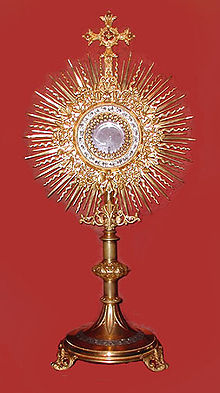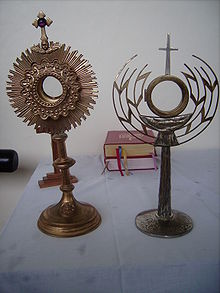
A monstrance, also known as an ostensorium (or an ostensory),[1] is the vessel used in Roman Catholic, Old Catholic and Anglican churches for the more convenient exhibition of some object of piety, such as the consecrated Eucharistic host during Eucharistic adoration or Benediction of the Blessed Sacrament. It is also used as reliquary monstrance for the public display of relics of some saints.[2] The word monstrance comes from the Latin word monstrare,[3] while the word ostensorium came from the Latin word ostendere. Both terms, meaning "to show", are used for vessels intended for the exposition of the Blessed Sacrament, but ostensorium has only this meaning.[2]
Liturgical context
In the Catholic tradition, at the moment of consecration the elements (called "gifts" for liturgical purposes) are transformed (literally transubstantiated) into the body and blood of Christ. Catholic doctrine holds that the elements are not only spiritually transformed, but are (substantially) transformed into the body and blood of Christ. Although the elements retain the appearance, or "accidents," of bread and wine, they become the body and blood of Christ. The presence of Jesus in the Eucharist is known as the doctrine of the Real Presence within the Roman Catholic tradition. Other Christians (notably Anglicans, Old Catholics, Mar Thoma, and Lutherans) accept the doctrine of the Real Presence, whilst rejecting transubstantiation as a philosophical concept. Owing to these beliefs, the consecrated elements are given the same adoration and devotion that Christians of these traditions accord to Christ himself.Within churches of these traditions the reserved sacrament serves as a focal point of religious devotion. In many of them, during Eucharistic adoration, the celebrant displays the sacrament in the monstrance, typically on the altar. When not being displayed, the reserved sacrament is locked in a tabernacle (more common in Roman Catholicism) or aumbry (more common in the other traditions mentioned).
Use and design
The Blessed Sacrament in a monstrance carried in a procession by Cardinal Danneels, wearing a humeral veil
Two monstrances, showing the contrast between the modern simplified
design on the right with its more ornate predecessor on the left
Monstrances are usually elaborate in design; most are carried by the priest. Others may be much larger fixed constructions, typically for displaying the host in a special side chapel, often called the "Chapel of the Blessed Sacrament". For portable designs, the preferred form is a sunburst[4] on a stand, usually topped by a cross.
Medieval monstrances were more varied in form than contemporary ones. Those used for relics, and occasionally for the host, typically had a crystal cylinder in a golden stand, and those usually used for hosts had a crystal window in a flat-faced golden construction, which could stand on its base. The monstrance was most often made of silver-gilt or other precious metal, and highly decorated. In the center of the sunburst, the monstrance normally has a small round glass the size of a Host, through which the Blessed Sacrament can be seen. Behind this glass is a round container made of glass and gilded metal, called a luna, which holds the Host securely in place. When not in the monstrance, the Host in its luna is placed in a special standing container, called a standing pyx, in the Tabernacle. Before the current design, earlier "little shrines" or reliquaries of various shapes and sizes were used.
When the monstrance contains the Host, the priest will not touch the vessel with his bare hands. Out of respect, he holds it with a humeral veil, a wide band of cloth that covers his shoulders (humera) and has pleats on the inside, in which he places his hands.
Controversy over the monstrance in the Ukrainian Byzantine Catholic Church
In recent years, the Ukrainian Greek Catholic Church has embarked on a campaign of de-Latinization reforms. These include the removal of the stations of the cross, the rosary and the monstrance from their liturgy and parishes. In response a group called the Society of Saint Josaphat (abbreviated as SSJK) has formed, with a seminary in Lviv. It currently has thirty students enrolled and is affiliated with the Society of St. Pius X.Critics claim that the SSJK's liturgical practice favours severely abbreviated services and imported Latin Rite devotions over the traditional and authentic practices of the Ukrainian Greek Catholic Church. Proponents counter that these symbols and rituals, influenced long ago by their Polish Catholic neighbors, have been practiced by Ukrainian Greek Catholics for centuries and that to deny them today is to deprive the people of a part of sacred heritage which they have learned to regard as their own.
Noted monstrances
- The Cathedral of Toledo, Spain boasts one of the most famous monstrances in European medieval history. Made of pure silver and encrusted with several jewels, it has merited several papal processions, acclamations and usage. Most recently among these is Pope Benedict XVI in his World Youth Day Apostolic Visit in 2011. It has also been immortalized in several 18th-century and 19th-century devotional handbooks.
- The Vatican monstrance (Latin: Ostensorio Vaticana) of is one of the most exquisite monstrances used by recent Popes, as it is an exact miniature of the Baldachin inside St. Peter's Basilica. It is complete in ornamentation including the angels adorning its rooftop. It was most recently used by Pope Benedict XVI.
- Saint Raymond Nonnatus and Saint Clare of Assisi are often portrayed with monstrances. Nonnatus used a Gothic box-style monstrance while Clare is often portrayed with a solar version.
- Founder of the Eternal World Television Network, Mother Angelica of the Annunciation is often portrayed with a golden solar monstrance pendant.
- The Church of St. Stanislaus Kostka, one of Chicago's famed Polish Cathedrals, is home to the largest monstrance in the world, a 9-foot-wide (2.7 m) Iconic Monstrance of Our Lady of the Sign. It is part of the planned Sanctuary of The Divine Mercy, which is being constructed adjacent to the church.[5] The Monstrance is to be installed in the sanctuary's adoration chapel, to be the focus of 24-hour Eucharistic Adoration. The clergy will conduct no liturgies or vocal prayers in the chapel, either by individuals or groups, as the space is meant for private meditation and contemplation.
- In the treasury at the St. Loreta Church in Prague, there is on display a monstrance featuring 6,000 diamonds.
- On top of the main dome of the Mariavite Temple of Mercy and Charity in Płock, Poland is a large monstrance. The monstrance is adored by four angels, each measuring almost 4 feet in height. The following Polish phrase is inscribed below the monstrance: Adorujmy Chrystusa Króla panującego nad narodami (in English, "Let us adore Christ the King reigning over all nations".)
- Perrot's Ostensorium was presented by 17th century fur trader Nicolas Perrot to the priests at the St. Francis Xavier Mission in 1686, located at what is now modern Green Bay, Wisconsin. It was buried by the priests when the local Indians became hostile and burned the mission buildings. It was dug up by accident in 1802 and is currently in the Neville Public Museum in Green Bay, Wisconsin. It is the oldest surviving physical artifact of French settlement west of the Alleghenies.[6]
Monstrances for displaying the Sacred host
-
-
Monstrance given to the Monastery of Alcobaça by Dom João Dornelas in 1412, with some later additions during the baroque period, National Museum of Ancient Art, Portugal.
-
Gold and enamel monstrance made in 1506 by Gil Vicente, and offered by king Dom Manuel I of Portugal to the Jerónimos Monastery. Nowadays in the National Museum of Ancient Art, Portugal.
-
-
Monument with a Monstrance in Rybnik, Poland in front of the Church of St. Laurence.
-
The large Patriarchal Monstrance was a gift from king D. João V to the Patriarchal Cathedral of Lisbon, and is made of solid gold, diamonds, rubies, sapphires and emeralds. It was commissioned in 1748 and finished in the second half of the 18th century, Lisbon Cathedral Museum, Portugal.
-
Monstrance from the museum in Pelplin, Poland.
-
-
-
-
Polish Rococo monstrances.
-
-
Late 18th to early 19th century 1,30 metres monstrance Asilo de Inválidos Militares de Runa, Portugal.




















